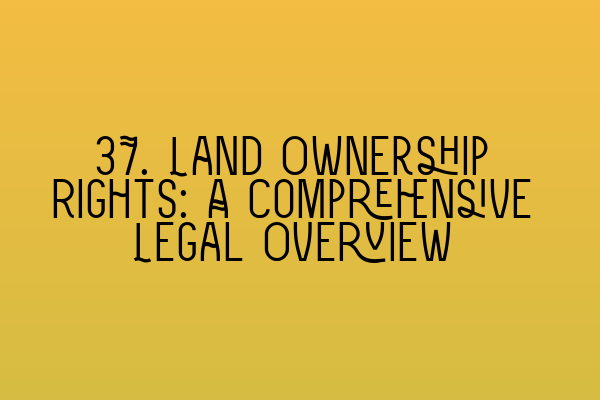37. Land Ownership Rights: A Comprehensive Legal Overview
At SQE Property Law & Land Law, we understand the importance of comprehensively understanding land ownership rights. Whether you are a property owner, buyer, or seller, having a solid grasp of the legalities surrounding land ownership can help you navigate the complexities and make informed decisions.
In this blog post, we will provide a detailed overview of land ownership rights, covering various aspects such as legal definitions, types of ownership, transfer of ownership, and related legal considerations. So, let’s dive in!
1. Legal Definitions
Land ownership rights refer to the legal interests and entitlements one has over a piece of land. It encompasses the right to possess, use, control, and enjoy the land, subject to certain limitations imposed by law. To fully understand land ownership rights, it is essential to have a clear understanding of the legal terms involved:
– Title: Title refers to the legal evidence of ownership over land. It provides the owner with legal rights and protections.
– Deed: A deed is a legal document that transfers ownership of land from one party to another. It contains specific details about the property and the terms of the transfer.
– Freehold: Freehold ownership grants the owner full ownership rights over the land and the buildings or structures on it.
– Leasehold: Leasehold ownership grants the owner the right to use and occupy the land for a specified period, typically through a lease agreement with the freeholder.
2. Types of Ownership
There are different types of land ownership rights recognized under the law. Understanding these types is crucial in determining the extent of your ownership and rights. Here are some common forms of land ownership:
– Sole Ownership: Sole ownership occurs when an individual or entity holds full ownership rights to a piece of land.
– Joint Tenancy: Joint tenancy involves co-ownership of land by two or more individuals with equal rights of survivorship. This means that if one owner passes away, their share automatically passes to the surviving co-owners.
– Tenancy in Common: Tenancy in common allows co-owners to hold unequal shares of land. Each co-owner has the right to dispose of their share independently, and their share does not automatically pass to the other co-owners upon death.
3. Transfer of Ownership
Transferring land ownership requires a legal process to ensure a smooth and valid transfer. The most common method of transferring ownership is through a sale or purchase transaction. Let’s explore the key steps involved:
– Agreement: The buyer and seller enter into a legally binding agreement, commonly known as a contract of sale, setting out the terms and conditions of the transaction.
– Conveyancing: Conveyancing is the legal process that facilitates the transfer of ownership from the seller to the buyer. It involves various tasks, such as property searches, drafting a transfer deed, and registering the new ownership with the Land Registry.
4. Legal Considerations
When dealing with land ownership rights, it is vital to consider certain legal aspects to protect your interests. Here are a few key considerations:
– Boundaries and Encroachments: Accurate identification and demarcation of boundaries are essential to avoid disputes with neighboring property owners. It is crucial to conduct a boundary survey and address any encroachments or disputes before completing a property transaction.
– Easements: Easements are rights granted to a person or entity to use another person’s land for a specific purpose. Common examples include rights of way and rights of access. Understanding existing easements and their impact on land ownership is crucial.
– Restrictive Covenants: Restrictive covenants are legal obligations tied to land ownership, dictating how the land can be used. It is important to identify and understand any restrictive covenants that may affect your ownership rights.
– Planning and Zoning Regulations: Local planning and zoning regulations impose restrictions on land use and development. Ensure that your land’s designated use aligns with these regulations to avoid legal issues.
By familiarizing yourself with these legal considerations, you can protect your rights and make informed decisions when it comes to land ownership.
For further resources and assistance in preparing for the SQE exams and enhancing your legal knowledge, check out these related articles:
– SQE 1 Practice Exam Questions: Enhance your preparation for the SQE 1 exam with our comprehensive practice exam questions.
– SQE 1 Practice Mocks FLK1 FLK2: Take advantage of our SQE 1 practice mocks to gauge your readiness and identify areas for improvement.
– SQE 2 Preparation Courses: Explore our SQE 2 preparation courses to enhance your understanding of property law and land law.
– SQE 1 Preparation Courses: Ace your SQE 1 exam with our specialized preparation courses designed to help you excel.
– SRA SQE Exam Dates: Stay updated with the latest SRA SQE exam dates to plan your study schedule effectively.
In conclusion, understanding land ownership rights is crucial for any individual or entity involved in property transactions. By grasping the legal definitions, types of ownership, transfer processes, and legal considerations, you can navigate the complexities with confidence and ensure the protection of your interests. If you need any legal assistance regarding land ownership rights, do not hesitate to contact SQE Property Law & Land Law. Our team of experts is here to help you every step of the way.
